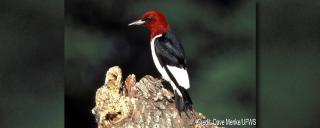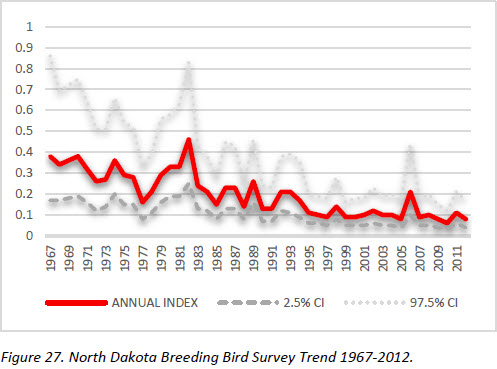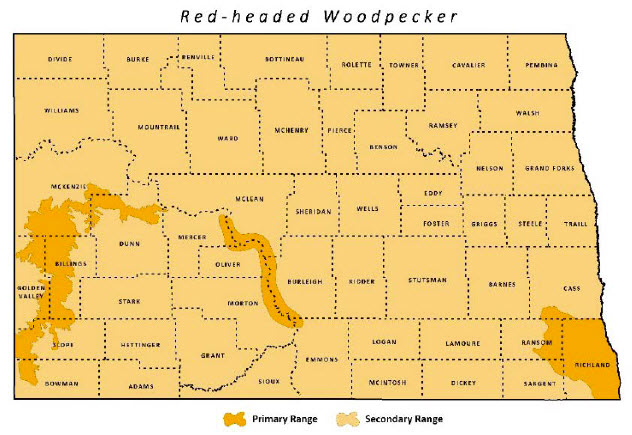
Red-headed Woodpecker
| Scientific Name | Melanerpes erythrocephalus |
|---|---|
| General Description | L 9.25”, WS 17”, 2.5 oz. Red head, black upper back and tail, white on rear of wings and upper rump. |
| Status | Occurs in North Dakota from mid-April to October. Peak breeding season early June to early August. |
| Abundance | Fairly common to rare. |
| Primary Habitat | Natural stands of mature deciduous trees along river bottoms, shelterbelts, wooded areas of towns. |
| Federal Status | Migratory Bird. |
| Reason for Designation | Red-headed Woodpeckers have experienced a significant population decline in North Dakota and throughout their range. It is included on the National USFWS Birds of Conservation Concern list, and also in Region 6, BCR 11 and 17 Partners in Flight (PIF) identifies the Red-headed Woodpecker as a Regional Concern Species, U.S.- Canada Concern Species, and a Common Species in Steep Decline. |
Locations and Conditions of Key Habitat
Preferred Habitat
Red-headed Woodpeckers can be found in deciduous woodland in the lowland or upland, along river bottoms, parks, shelterbelts, along roadsides, in open agricultural areas, or in cities. Some habitats it uses can be described as savannah-like. Nest 5-80 feet off the ground in the dead tops or stumps of oak, ash, maple, elm, cottonwood, willow or occasionally utility poles. Cavity is 8-24 inches deep. Breeding pairs may use the same nesting cavity for several years. Forages on the ground, in shrubs, or on mostly dead trees for insects such as ants, wasps, beetles; rarely drills into trees for insects. They will also feed on corn, nuts, berries, and eggs or young birds of passerines.
Key Areas and Conditions for Red-headed Woodpecker in North Dakota
No specific sites have been identified. The upper portion of the Little Missouri River, the lower Missouri River Valley, and the southern portion of the Red River Valley appears to have supported the highest population.
Problems Which May Affect this Species
Habitat
Destruction and/or degradation of riparian habitat and lack of riparian regeneration are primary limiting factors. Removal of dead trees or branches limits nest site availability.
Other Natural or Manmade Factors
Red-headed Woodpeckers were once a popular target for hunters and a bounty was even offered for each head because of the belief they were major agricultural pests. May be killed by automobiles while plucking injured or dead insects from roads. Some mortality from collisions with communication towers. Other birds may compete with Red-headed Woodpeckers for nesting cavities.
Research and Survey Efforts
Current Research or Surveys
- Nothing specific to the species in North Dakota.
Previous Research or Surveys
- Little effort has been applied to research or surveys specifically for Red-headed Woodpeckers in North Dakota.
- Fair number of published reports and gray literature in other areas of the species range, but no in-depth study of this species has been conducted.
Additional Research or Surveys Needed
- The status of the Red-headed Woodpecker in North Dakota is largely unknown. A survey should be conducted to determine the occurrence of this bird in North Dakota.
- Explore basic demographic information, ecological relations with other organisms that use nest and roost holes created by the woodpeckers, or the relationship with mast producing trees in North Dakota.
- Explore changes in land use patterns and the effect on Redheaded Woodpeckers.
Population and Trend Estimates

- PIF Global Population Estimate: 1,200,000
- PIF North American Population Estimate: 1,200,000
- PIF North Dakota Population Estimate: 7,000
- North Dakota BBS Trend: see figure 27
- Survey-wide BBS Trend 1966-2012: -2.59
Management Recommendations
- Protect riparian corridors.
- Leave snags and dead trees.
- Plant mast producing trees such as oak.
- Remove starlings if competition is present.
- Construction of communication towers should follow the guidance of “Service Interim Guidelines for Recommendations on Communications Tower Siting, Construction, Operation, and Decommissioning” and American Bird Conservancy Collision Program framework.
Monitoring Plans
According to the Partners in Flight Landbird Conservation Plan, long-term population trend monitoring such as the Breeding Bird Survey is generally considered adequate, but may not account for some issues (e.g. bias). Ensuring all BBS routes are conducted annually is priority.
2005-2015 Progress
The Red-headed Woodpecker has moved from a Level II to a Level I Species of Conservation Priority.

Note: A listing of works consulted when compiling the information on this page may be found in the 2015 State Wildlife Action Plan.
